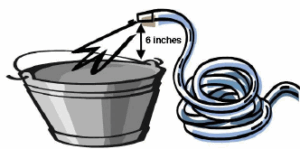Location
-
3010 Highway 126
Blountville, TN 37617
Mailing
-
PO Box 469
Blountville, TN 37617
Hours
-
7 AM - 5:30 PM
Monday - Thursday
It is that time of year when the temperatures start to dip below freezing and we have a few pointers for you.
Freezing Weather Protection
Before the onset of cold weather, prevent freezing of water supply lines and pipes by:
Letting cold water drip from the faucet served by exposed pipes. |
Draining water from swimming pools and water sprinkler supply lines. |
Removing, drain and store hoses. |
Closing inside valves supplying outdoor hose spigots. Open outside hose spigots to allow water to drain. |
Keeping the outside valve open so that any water remaining in the pipe can expand without causing the pipe to break. |
Insulating water pipes by carefully wrapping them with ends butted tightly and joints sealed with tape. Newspapers can provide some degree of insulation and protection to exposed pipes. |
Opening kitchen and bathroom cabinet doors to allow warmer air to circulate around the plumbing. |
Leaving the heat in your home set to a temperature of no lower than 55 degrees F, if you’re away during cold weather. |
Thawing Frozen Pipes
If you turn on a faucet during freezing weather and only a trickle comes out, suspect a frozen pipe. The following are tips to thaw a frozen pipe:
Keep the faucet open. Running water through the pipe will help melt ice in the pipe. After flow is achieved, allow faucet to drip to prevent refreezing. |
Apply heat to the section of frozen pipe using an electric heating pad wrapped around the pipe, an electric hair dryer, a portable space heater (kept away from flammable materials) or wrapping pipes with towels soaked in hot water. Do not use a blowtorch, kerosene or propane heater, charcoal stove or other open flame device. |
Apply heat until full pressure is restored. If you are unable to locate the frozen area, if the frozen area is not accessible or if you cannot thaw the pipe, call a licensed plumber. |
Check all other faucets in your home to find out if you have additional frozen pipes. |
Future Freeze Protection
Consider relocating exposed pipes to provide increased protection from freezing. A professional can relocate pipes if the home is remodeled. |
Add insulation to attics, basements and crawl spaces. |
*Please be aware that letting faucets drip will increase your monthly water bill.
Click here for current rates:
Please note that if the 25th falls on a Friday, Saturday, Sunday or legal holiday, a customer will have until the following business day to pay their
bill before the past-due fee is automatically added to their account and disconnected for nonpayment.
If your payment has not been received by 5:30 p.m. on the 25th, the Utility will automatically add a $50 past-due fee to your account. If payment
is not received by this date and time, services will be disconnected for non-payment on the 26th.
Clarification on use of the night/drop box: If a delinquent payment is made through the night/dropbox after 5:30 p.m. on the 25th of the month,
the payment must include the payment and the $50 past-due fee in full to prevent disconnection for non-payment on the 26th.
50 Cross Connection Questions, Answers, & Illustrations
Blountville Utility District makes every effort to ensure that our customers enjoy a continuous supply of safe drinking water. We appreciate the help of our customers to maintain the quality of our water supply.
Cross Connections can cause the water system to become contaminated. A cross connection is a link with the public water supply and a possible source of contamination. An example of a cross connection would be a garden hose submerged in a source of contamination such as a swimming pool, car radiator or other liquid. If a water main break should occur or if a fire pumper used a fire hydrant while the hose was submerged in a source of contamination, the contaminant could be pulled back into the public water supply. This occurrence, known as backflow, can be prevented.
One simple way to stop backflow is by using an air gap. An air gap can be created by arranging your hose so that the end is at least six inches above the top rim of the container it is being used to fill. This air gap will prevent the contaminant from being siphoned into the water supply.

Another method of preventing backflow with a garden hose is using a device known as a vacuum breaker. Vacuum breakers are inexpensive devices that can be screwed onto your outside faucet. These devices will prevent contaminants from being siphoned back into your plumbing and the public water system.

More hazardous cross connections or cross connections created with permanently installed plumbing may require more sophisticated devices known as reduced pressure backflow preventers. These devices are much more complicated and must be tested annually by certified testers.
For more information on preventing cross connections and protecting our water supply, contact Blountville Utility District at (423) 323-2189.
REMEMBER: Never submerge your garden hose in anything you would not want to drink